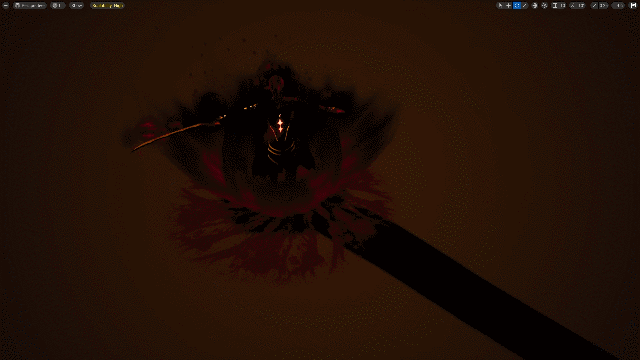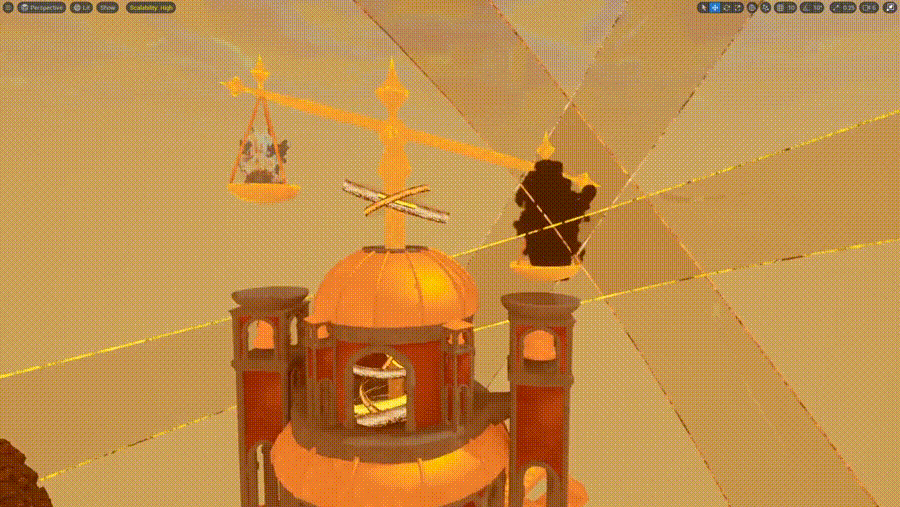ETERNAL MACHINATION
2023 to 2024

capstone project (MS)
Design Process
Key Achievements
-
Designed immersive levels blending gameplay mechanics with environmental storytelling.
-
Developed innovative shadow-based mechanics for combat and traversal.
-
Created visually striking VFX using Niagara systems (e.g., shadow trails, AOE effects).
-
Directed cohesive aesthetics aligning character design with world-building.
-
Integrated narrative elements organically into gameplay through environmental design.
-
Programmed custom systems enhancing player experience (portals, targeting systems).


Level & World Design
-
Environmental Narrative:
-
Designed immersive levels that integrate storytelling into the environment.
-
Example: The First Sanctum reflects the heavenly domain of Archons through floating rococo-inspired architecture, vibrant flora, and cascading waterfalls.
-
Contrast: Eldritch Marshes showcase desolation with skeletal ruins, polluted rivers, and industrial waste, emphasizing humanity's destructive impact.
-
-
Embedded lore into landmarks like the Grand Scales of Cosmic Balance and skeletal ruins, enhancing player immersion.
-
-
Level Structure:
-
Created semi-open traversal paths that balance exploration and linear progression.
-
Developed Archonic Portal Gates to reduce traversal time while maintaining immersion by visually previewing connected destinations.
-
-
Interactive Points of Interest (POIs):
-
Integrated environmental puzzles, lore chunks, and interactive objects to reward exploration.
-



Visual Effects (VFX) & Shaders
-
Character-Centric VFX:
-
Created dynamic particle effects for Seethe’s hair using Niagara ribbon emitters, simulating flowing shadows.
-
Designed shadow trails for movement and attacks to emphasize Seethe’s chaotic nature.
-
-
Environmental VFX:
-
Developed shaders for water in Eldritch Marshes using Gerstner wave functions to simulate poisonous swamp water.
-
Implemented cel-shading and outline shaders for objects in the First Sanctum to achieve a cohesive fantasy art style.
-
-
Boss Fight VFX:
-
Created effects like earthquake ground splits, reticle targeting, and laser beams during boss fights using Niagara systems.
-

Aesthetics & Art Direction (in-game)
-
Character Design:
-
Helped conceptualize Seethe in-game as an ambiguous, non-human entity with chains symbolizing imprisonment and shadow-infused armor reflecting their chaotic nature.
-
Details: Flowing shadow hair, cape physics using Chaos Cloth system, and chained sword (Sepulchre) connecting Seethe to their imprisonment.
-
-
-
World-Building:
-
Directed visual themes for levels:
-
First Sanctum: Heavenly ambiance with rococo-inspired architecture.
-
Eldritch Marshes: Post-apocalyptic wasteland with skeletal structures.
-
-



Gameplay Programming
-
Custom Systems Development:
-
Implemented gameplay systems such as dynamic portals, combat mechanics (light/heavy attacks), special abilities like shadow waves, and interactive UI elements (e.g., health bars, compass systems).
-
-
AI Integration:
-
Collaborated on enemy AI design in the levels to create challenging encounters that adapt to player strategies.
-

UI/UX Design
-
HUD Elements:
-
Designed intuitive HUD elements like health bars, focus meters, compass systems, and task indicators that dynamically update based on player actions.
-
-
Tutorial Integration:
-
Implemented Archollia as a guiding voice during onboarding sequences with voice acting narrating mechanics alongside visual demonstrations.
-
Retrospectives & Iterative Design
-
Sprint-Based Development:
-
Participated in bi-weekly sprint planning to set achievable goals and adapt the roadmap based on progress and feedback.
-
Conducted retrospectives at the end of each sprint to evaluate successes, identify bottlenecks, and refine workflows.
-
Example: After Sprint 3, feedback from playtests revealed that onboarding was unclear. This led to the introduction of Archollia as a narrator for tutorial guidance.
-
-
Collaborated with team members to adjust scope dynamically, ensuring features like combat fluidity and environmental storytelling were prioritized.
-
-
Playtesting Feedback Integration:
-
Organized regular playtests with peers and external testers to gather insights on mechanics, level design, and onboarding clarity.
-
Example: Early playtests showed players struggled with traversal between islands in the First Sanctum. This led to the implementation of Archonic Portal Gates for faster navigation.
-
-
Iterated on combat mechanics based on feedback about responsiveness and visual clarity, refining animations and attack timing for better player feedback.
-

Design Processes
-
Collaborative World-Building:
-
Worked closely with narrative designers to align environmental storytelling with lore.
-
Example: Designed skeletal ruins in the Eldritch Marshes to visually communicate the Guardian Beast’s death and humanity’s exploitation of resources.
-
-
-
Prototyping & Iteration:
-
Developed early prototypes for shadow-based mechanics (e.g., Shadow-Spear Movement) using placeholder assets to test functionality before integrating final animations and VFX.
-
Iteratively improved shaders and VFX through multiple passes based on team feedback:
-
Initial water shader lacked depth; later iterations introduced Gerstner wave functions and reflective layers for a more poisonous appearance.
-
-
-
Cross-Discipline Collaboration:
-
Coordinated with animators, audio engineers, and UI artists to ensure seamless integration of assets into gameplay systems.
-
Example: Worked with animators to synchronize Seethe’s attack animations with Niagara particle effects for shadow trails.
-
-
Postmortem Reflections
-
What Worked Well:
-
Strong team communication ensured alignment across disciplines despite a large number of external contributors.
-
Iterative design processes allowed rapid prototyping and refinement based on feedback.
-
-
Challenges Faced:
-
Overscoping risks required constant prioritization; some features like additional combat styles had to be cut for time.
-
External member availability occasionally delayed asset delivery, but proactive task reallocation mitigated major disruptions.
-
-
Lessons Learned:
-
Early playtesting is invaluable for identifying usability issues (e.g., unclear onboarding). Starting this process sooner could have saved time on rework later.
-
Maintaining a flexible roadmap allowed the team to adapt effectively to unforeseen challenges while delivering a polished experience.
-